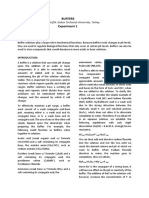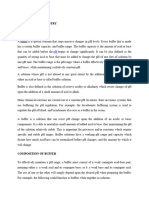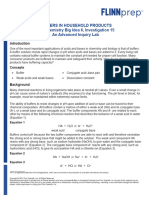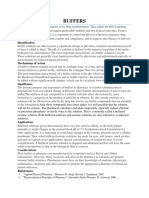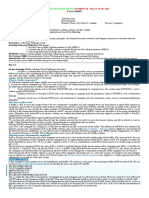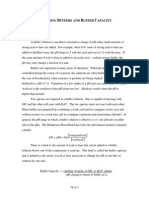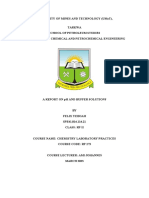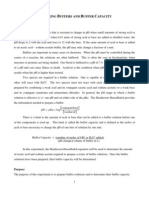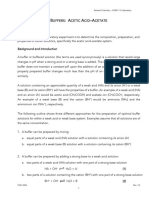0 ratings0% found this document useful (0 votes) 108 views8 pagesBuffer Lab INV 16
Copyright
© © All Rights Reserved
We take content rights seriously. If you suspect this is your content,
claim it here.
Available Formats
Download as PDF or read online on Scribd
The Preparation and Testing
of an Effective Buffer: How
Do Components Influence a
Buffer's pH and Capacity?
S@ CENTRAL CHALLENGE
You and your classmates are being asked to prepare and test a series of buffers
to be used in an important biochemical project, Each group will be given an
assignment card for one of the butlers, Once you've performed your experimental
design to achieve the assignment on the card, you will share and compare your
results with those of your classmates, You will then argue, with evidence, whether
you've completed your assignment or need to rely on the product of another group.
Scientists often share data and information with other researchers, The need to
interact with others is not an indication of failure provided yout final argument
is sound,
88 CONTEXT FOR THIS INVESTIGATION
‘Many important biochemical reactions occur only over a small range in pH.
Living organisms dependent upon these reactions rely on chemical systems called
buffers to maintain a relatively constant pH when acids or bases are added to their
environment, The company contracting your chemistry class aims to produce a
variety of bacteria designed to destroy harmful living agents. The bacteria must,
be grown in a medium with a pH similar to that of the environment they will be
functioning in, This medium must be able to maintain a pH within plus or minus
‘one unit of the target pH for the bacteria it will support when a strong acid or base
isadded. Your job will be to produce a buffer for such a medium.
As buffers must neutralize both acids and bases, they must contain both a base and
an acid. The question is, how do we prevent the acid and base in the buffer from
simply neutralizing one another, thus rendering the buifer useless? We must also
consider how much acid and base our buffer should be able to neutralize. Buffers
are most effective when they've been produced so they may neutralize a reasonable
amount of either acid or base. The quantity of acid or base that may be added to
a buffer while maintaining a relatively constant pH is a function of the buffer's
capacity,
133�134
ag
INVESTIGATION 16
2]
PRELAB GUIDING QUESTIONS/SIMULATIONS
4, How does a buffer solution resist a change in pH?
2. Why would HCl and NaOH be 2 poor choice for an acid-base pair to make a buffer?
3, Goto the animation at:
httpfintrochem,chem.okstato.edu/DCICLA/pHbuffer20.htm!
Create a “butfer solution” using equal volumes (100 mL each) of 0.10 M nitric acid
and 0.10 M sodium nitrate. Insert the probes and record the pH in the table below.
Remove the probes. Then go to Part Il of the simulation and add first 0.001 moles
of HCl and then the same amount of NaOH. Record the pH in each case. Remove
the probes, return to Part I, and try the next combinations. Complete the first three
lines of the table below.
Remake the “buffers” using the same volumes of L.0 M components (increased
molarity by 10X), Add the same 0,001 moles of HCl and NaOH to the “stronger”
buffers. Complete the middle of the table,
Finally, repeat the process adding 0.011 moles (additional 10X more) of strong acid
and base, Complete the lat three lines of the table.
Acid-Base Pair pHof“butfer” | pH with 0.001 mot | pHtwith 0.001 mol
HCladded NaOH added
HINO, and NaNO,
HCHO, and
NaC HO,
NH,Cland NH,
Increase molarity
10X
TINO, an
NaNO,
HIC,HO, and
NaC HO,
NH,Cland NH,
pH with 0.011 mol | pH with 0.011 mol
HCladded NaOH added
HINO, and NaN
HCHO, and
Nat,H,0,
NH,Cland NH,
'. Write a general chemical equation to represent the equilibriuin that exists in an
aqueous system of the weak acid, HA as it ionizes im water, Asstume the weak acid to
be HC,H,0, (0.10 M), with a K, value of 1.8 x 10%, What is the pH? What does the�BUFFER DESIGN —fS] 135
addition of NeC,H,O, do to the equilibrium you just represented? Use these chemical
principles to explain why the first pH recorded from the simulation is so much larger
than your calculated value for pure 0.10 M acetic acid
3, How do the pk, values for acetic acid and ammonium ion (K, = 5.6 x 10%) compare
to the pH values for the frst two buffers in the simulation? Explain this phenomenon,
. Why don’t the pH values change when the component concentrations are increased?
4, Write a general equation to show how a buffer containing an acid HA and the salt ofits
conjugate base, NaA, would respond to the addition of each ofthe following
4. ‘The strong acid, HCL
b. The strong base, NaOH
5, Why are the pH changes so noticeable with the last two additions of strong acid and base
in the simulation?
6. Which of the two concentration combinations would be most efective for an
antibiological agent’ buffs?
‘Bi EXPLANATION TO STRENGTHEN STUDENT UNDERSTANDING
A buffer is a solution designed to resist the changes in pH that occur when small
amounts of acid or base are added. Many important chemical reactions occur
only over a small pH range, Ifit were not for the presence of buffer systems in
the blood of human beings, the intake of a small glass of orange juice could
lead to a dangerous condition called acidosis that would lead to seizures, loss of
consciousness, coma, and eventually death. Clearly buffers are very important.
‘You were reminded in the Context for this Investigation section that because buters
mast neutralize both acids and bases, they must contain a base and an acid. In that
section you were asked how we prevent the acid and base in the buffer from simply
neutralizing one another, thus making the buifer useless. You may have recalled or
determined during the Prelab Guiding Questions section that the answer to this,
problem is to use an acid and base that form a conjugate pair. A conjugate acid-base
pair isa set of two species that differ from one another by one easily removable
hydrogen ion (a proton), Should the members ofa conjugate pair neutralize one
another, they will simply reform the same species, hence there is no neutralization,
Itis critical that both members of the conjugate pair are weak as the conjugate of a
strong species wil! be so weak it will be essentially neutral and could not effectively
neutralize any added acid or base. A good example of a conjugate pair for a bufler would
be hydrofluoric acid (HP) and fluoride ion (F), as HE can neutralize added base:
HF(aq) + OH (ag) > Fag) + 1,010)
and F can neutralize added acid:
F (aq) + H,0"(ag) > HF(aq) + H,0()�INVESTIGATION 16
Be
It is also important to remember that we cannot simply obtain an independent
anion (or cation) from our stockroom shelf. Rather we require a soluble salt as
the source of the required ion, In the case of our sample HFYF buffer, we might
combine hydrofluoric acid with some sodium fluoride salt. In this experiment,
you will combine different pairs of chemicals in an effort to create a buffer of a
particular pH.
Since buffers contain weak acids, it is possible to calculate the pH es you would
for any weak acid, using the K, expression, with one significant difference: ‘There is
some common ion (actually the conjugate base of the weak acid) in the solution.
Consequently, use the general weak acid equation:
HA(aq) + H,0() = H,O"(ag) + A\(ag) produces the following expression
x, = 180°]
: (HA)
As there is already conjugate base, A’, present in the solution, when equilibrium
concentrations are inserted into the expression, the [H,O*] will not be equal to the
(x.
Buéfers are most effective when they are equally prepared to neutralize acids
cr bases. For this to be true, the [HA] should approximately equal the [A]
Examining the expression for the general buffer equation above, we see that such a
circumstance would result in the K, of the conjugate acid in the buffer being equal
to the (H,0"}. The negative logaritiimic form of this equation indicates that the pi,
is equal to the pH of the buffer. In summary, when [HA] = [4°]
K_=[H,O"] and pK, = pH
"The effectiveness of a buffer — that is, its ability to neutralize added base or a
is called the buffers capacity.
88 PREPARATION
Materials
010M Sodium acetate | 0.20.48 2150mL | Stirring vod
acetic acid (aCH,COO) —_| sodium beakers or magnetic
(CH,COOH) hydroxide mixer (use care
K,-18x10 «Neort) sxound pit
elecirades)
6.10Mammonis | Ammonis — | 020 2-250mL | pl meter (or
(NH) chloride (NH,CD | hycrochtoric | beakers pH probe with
of NH, acid (HCI) an interface)
s7 x10" or pH Hydrion
Paper�BUFFER DESIGN
0.10.Msodium — | Sodium Milligrar (or | 2-50 mi. burets
dlhydrogen hydrogen centigrar)
phosphate Phosphate balance
(Nati,PO,) {Na,HPO,) (also
K, of PO, called sodium
63x16" biphosphate)
0.10 citric acid [ Sodium Soooputaor | 2mi.
(HCHO, K,= | aihyairogen spatula volumetric flask
71 <1 citrate
(NaH.C4,0.)
0.10Msodium |} Sodiumeitrate | 100 mL.
monohydrogen | (NaC,HO.) | graduated
citrate cylinder
(Ne,FICH.0,)
(also called
sodium bicitrate)
K = 41x 107
Sample pH7 | Sodiumchloride | 10 mL Utility stand
butler (Nac) graduated
oylinder
Safety and Disposal
Be sure to check the appropriate Material Safety Data Sheets (MSDS) for all
chemicals before beginniag the laboratory,
Splash-proof safety goggles should be worn as when handling any chemical in the
Jab, Aprons or lab coats should also be worn if available.
Neutralize acids and bases with the corresponding bases and acids before flushing
down the sink. Neutralized solutions should he preceded and followed by large
Quantities of water during flushing, These disposal procedures should be followed
unless your local state/jurisdiction directs you otherwise
& PRACTICE WITH INSTRUMENTATION AND PROCEDURE
Procedure
4. Rinse a buret with 10 ml 0750 of 6.20 2M HCL Pill the buret and clamp it tothe w
stand. Repeat this process with a second buret and the 0.20 M NaOH.
2. Set up and calibrate your pH meter according to your teacher's instructions,
Place 50.0 ml. of water into each of two 150 ml. beakers, Lower the pH meter’s electrode
or probe into one ofthe beakers, Determine the pH. Record this value neatly in a
prepared table in your lab notebook.
4 Ram in as close as possible to 1.00 ml. of HCI solution, sticring the solution in the beaker
thoroughly. Do not use the electrode to stir. Record the new pH value,
137�138
J _ INVESTIGATION 16
ae
5, Repeat Steps 3 and 4 with the second beaker adding 1.00 mL of the NaOH solution.
6. Finally, safely discard the solutions and fill the two beakers with $0.0 mL each of the j
butier. Repeat Steps 3-5 using the butfer solutions instead of the water. |
Give an explanation for what you've observed.
8 INVESTIGATION
Your teacher will provide you with a card that indicates your mission. Consider the
list of materials available and hypothesize how best to fulfill your mission using the
materials available, The list includes a number of chemicals that are not required to
complete your task.
Procedure
‘The company contracting your class has requested that each group prepare a 100
‘mi. sample of their buffer and test it in the hope that it falls within +/- 0.5 of the
target pH stated on the “Mission Card” and that @ 50 ml. sample can maintain a
relatively constant pH (within one pH unit of the initial value) with the addition of
up to 20 ml. of 0.20 M HCI or NaOH.
1 Neatly record your hypothesis in an “Ifwe combine ... then our buffer will.” forme.
‘The procedure, including the masses and volumes of ail materials used, should be neatly
secorded in your lab notebook. Use a data table for all quantitative values, Be sure to show
all supporting calculations in an adjacent column or section of your lab repost. Have your
teacher check your hypothesis before you begin to create your buffer and test it.
2. Once your teacher has given you permission (you may have to modify your hypothesis
before you are allowed to proceed), go ahead and test your hypothesis. First check your
target pH by placing 50.0 mi. of your butfer into a 250 ml. beaker and lowering the pH
‘meter electrode or probe into the sample, Record the initial pH in the first line of a
‘able with columns headed “Volume of Acid Added!” and “pH.”
3. Each lab group must follow the same procedure for capacity testing. Measure a second
50.0 ml. portion of your buffer. Why might your total volume of bufier slightly exceed
100 mL? All measurements involve some degree of uncertainly, As the company is
allowing you to be within plus or minus 0.5 units of your target pH, co you think a slight
{increase in volume is significant in this case?
4, Begin your capacity testing by using the buret from the Practice with Instrumentation
and Procedure section to add about 5.00 ml. (record the actual ongoing volume
precisely) increments of 0.20. HCI to your buffer. Use yout table ta record the pH after
«each addition {followed by thorough stirring), Once about 10.00 mi of acid has been
added, change to approximately 2.00 ml, increments until you reach a total volume of
16,00 ml. of acid added, Now add the acid in approximately 1.00 mL increments untill
you've reached a total volume of 30.00 ml, of acid added. You may now increase the
‘volume of each increment to about 2.00 mL. until you reach a total of 40.00 mI. added.
"The last couple of increments may be about 5.00 ml, each.�igure 1. pH probe, hot plate, and buret setup
4, Repeat your capacity testing for base addition by following the same procedure with the
addition of 0.20.M NaOH to your second 50.0 mL sample of buifer. The volumes added
should follow the same pattern as before, but base is being added. These precise volumes
and pH values may be recorded in two new columns added to the data table you've
already prepated.
6. Two graphs will be plotted, one of pH versus volume of acid acided to a buffer” and one
of “pH versus volume of base added to a buffer
1. Allstudent data and graphs will be displayed. You will share and compare your results with
those of your classmates, You will then argue with evidence whether you've completed your
assignment or need to rely on the product of another group. Be sure to give credit where it
is due and cite the source of any ideas or information you've borrowed,
Data Collection and Computation
1. Complete neatly labeled graphs for the data tables you've prepared.
2. Calculate the anticipated pH for the buffer you were assigned. Include neat calculations
in your report.
3, Determine the yolume of aid and base your buffer was able to neutralize before allowing
a pH change of more than one unit, Use the volume with the HCVINaOH molarties to
determine the number of moles of acid and base your butfer was able to neutralize�140 G8 INVESTIGATION 16
pers
me
4 Consider 50.0 ml. ofthe buffer you prepared and calculate the ratio of (moles of added
Acid neutralized) to (moles of base component in the buffer). Do the same calculation for
(moles of added base neutralized) to (moles of acid component in the butfer), State both
ratios in the form of x1, Report the value for x to two significant figures
Argumentation and Documentation
Examine classmates’ graphs. Was each buffer more effective for buffering added
acid or base?
Ff POSTLAB ASSESSMENT
'. Suppose, using preparation, an adltione! 10 ml. of cistilled water was added to your
butfer by mistake
8. What effect would this have on your buffers pH? Explain,
'. Would this affect your buffer’s capacity? Explain,
2. Given a solution of hydtocyanic acid (HCN), what additional reagent or reagents are
needed to prepare a buffer from the hydrocyanic acid solution?
4. Explain how this butfer solution resists a change in pH when moderate amounts of
strong acid are added. Use a chemical equation in your explanation
. Explain how this buffer solution resists a change in pH when moderate amounts of
strong base are added, Use @ chemical equation in your explanation,
4. A buffer solution contains 0.20 moles of methanoic acid, HCOOH, and 0.30 moles of
Sodium methanoate, NeCOOH, in 1.001. ofthe busfer. The acid ionization constant, Ky
‘of metharoic acid is 1.8 x 104,
a. Calculate the pH of this solution.
4. Compare the capacity ofthis butier to neutralize added acid to its capacity to
neutralize addled base. Explain your answer completly
© 1f0.10 moles of HCl gas solution were bubbled through a liter of the butfer, what
would happen to the pH? How would this addition affect the buffers capacity to
neutralize added acid and base inthe future? Answer the question fall, including
equations and calculations where necessary,
{3 SUPPLEMENTAL RESOURCES
Links
Abraham, Michael, John Gelder, and Tom Greenbowe. “Buffered Solution”
Molecular Level Laboratory Experiments (MOLB). Accessed August 16, 2012
nttp:/fintrochem.chemokstate.edu/DCICLA/pHbutfer20, him!




